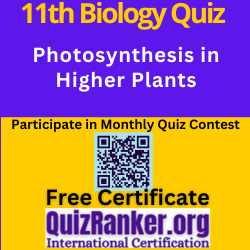Enhance your knowledge with our Photosynthesis in Higher Plants MCQ Test for 11th Biology Chapter 11. This MCQ Test covers light reactions, Calvin cycle, and factors affecting photosynthesis to help you understand this vital plant process.
Attempt Photosynthesis in Higher Plants MCQ Test
Attempt Chapter wise 11th biology MCQ Test and Monthly Quiz contest of Biology 11th grade.
Summary for Photosynthesis in Higher Plants MCQ Test
Plants make their own food through photosynthesis. This process happens in green parts of plants, mainly leaves. Leaves take in carbon dioxide from the air through tiny holes called stomata. Inside leaf cells, special structures called chloroplasts use light energy to turn carbon dioxide and water into food (sugars) and oxygen.
Photosynthesis has two main steps:
- Light reaction: Plant pigments catch sunlight. This energy is used to split water molecules, releasing oxygen and creating energy-carrying molecules.
- Carbon fixing: Plants use the energy from step 1 to turn carbon dioxide into sugar. This happens through a process called the Calvin cycle.
Some tropical plants have a special way of doing this called C4 photosynthesis, which helps them save water in hot climates.
Chapter wise biology 11th grade mcq
Chapter 1 The Living World MCQ Test
Chapter 2 Biological Classification MCQ Test
Chapter 3 Plant Kingdom MCQ Test
Chapter 4 Animal Kingdom MCQ Test
Chapter 5 Morphology of Flowering Plants MCQ Test
Chapter 6 Anatomy of Flowering Plants MCQ Test
Chapter 7 Structural Organisation in Animals MCQ Test
Chapter 8 Cell The Unit of Life MCQ Test
Chapter 9 Biomolecules MCQ Test
Chapter 10 Cell Cycle and Cell Division MCQ Test
Chapter 11 Photosynthesis in Higher Plants Quiz
Chapter 12 Respiration in Plants MCQ Test
Chapter 13 Plant Growth and Development MCQ Test
Chapter 14 Breathing and Exchange of Gases MCQ Test
Chapter 15 Body Fluids and Circulation MCQ Test
Chapter 16 Excretory Products and their Elimination MCQ Test
Chapter 17 Locomotion and Movement MCQ Test
Chapter 18 Neural Control and Coordination MCQ Test
Chapter 19 Chemical Coordination and Integration MCQ Test
Source for Study
Total Views: 24


